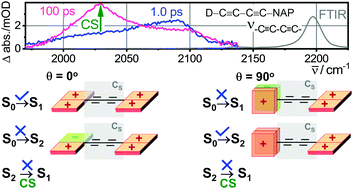Symmetry controlled photo-selection and charge separation in butadiyne-bridged donor–bridge–acceptor compounds†
Abstract
Electron transfer (ET) in donor–bridge–acceptor (DBA) compounds depends strongly on the structural and electronic properties of the bridge. Among the bridges that support donor–acceptor conjugation, alkyne bridges have attractive and unique properties: they are compact, possess linear structure permitting access to high symmetry DBA molecules, and allow torsional motion of D and A, especially for longer bridges. We report conformation dependent electron transfer dynamics in a set of novel DBA compounds featuring butadiyne (C4) bridge, N-isopropyl-1,8-napthalimide (NAP) acceptors, and donors that span a range of reduction potentials (trimethyl silane (Si-C4-NAP), phenyl (Ph-C4-NAP), and dimethyl aniline (D-C4-NAP)). Transient mid-IR absorption spectra of the C![[triple bond, length as m-dash]](https://www.rsc.org/images/entities/char_e002.gif) C bridge stretching modes, transient spectra in the visible range, and TD-DFT calculations were used to decipher the ET mechanisms. We found that the electronic excited state energies and, especially, the transition dipoles (S0 → Sn) depend strongly on the dihedral angle (θ) between D and A and the frontier orbital symmetry, offering an opportunity to photo-select particular excited states with specific ranges of dihedral angles by exciting at chosen wavelengths. For example, excitation of D-C4-NAP at 400 nm predominantly prepares an S1 excited state in the planar conformations (θ ∼ 0) but selects an S2 state with θ ∼ 90°, indicating the dominant role of the molecular symmetry in the photophysics. Moreover, the symmetry of the frontier orbitals of such DBA compounds not only defines the photo-selection outcome, but also determines the rate of the S2 → S1 charge separation reaction. Unprecedented variation of the S2–S1 electronic coupling with θ by over four orders of magnitude results in slow ET at θ ca. 0° and 90° but extremely fast ET at θ of 20–60°. The unique features of high-symmetry alkyne bridged DBA structures enable frequency dependent ET rate selection and make this family of compounds promising targets for the vibrational excitation control of ET kinetics.
C bridge stretching modes, transient spectra in the visible range, and TD-DFT calculations were used to decipher the ET mechanisms. We found that the electronic excited state energies and, especially, the transition dipoles (S0 → Sn) depend strongly on the dihedral angle (θ) between D and A and the frontier orbital symmetry, offering an opportunity to photo-select particular excited states with specific ranges of dihedral angles by exciting at chosen wavelengths. For example, excitation of D-C4-NAP at 400 nm predominantly prepares an S1 excited state in the planar conformations (θ ∼ 0) but selects an S2 state with θ ∼ 90°, indicating the dominant role of the molecular symmetry in the photophysics. Moreover, the symmetry of the frontier orbitals of such DBA compounds not only defines the photo-selection outcome, but also determines the rate of the S2 → S1 charge separation reaction. Unprecedented variation of the S2–S1 electronic coupling with θ by over four orders of magnitude results in slow ET at θ ca. 0° and 90° but extremely fast ET at θ of 20–60°. The unique features of high-symmetry alkyne bridged DBA structures enable frequency dependent ET rate selection and make this family of compounds promising targets for the vibrational excitation control of ET kinetics.



 Please wait while we load your content...
Please wait while we load your content...